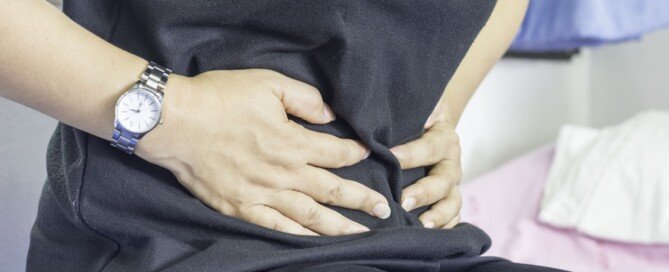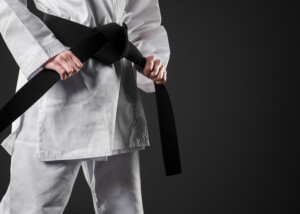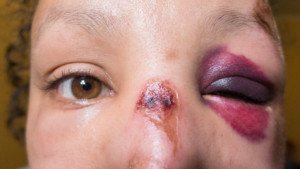Can Hearing Loss Be Prevented in Old Age?
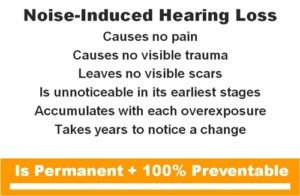
A lot of hearing loss that occurs in old age can be prevented; being “hard of hearing” does not have to be a part of aging if you know how to protect your ears.
Noise-induced hearing loss is a leading cause of hearing impairment.
According to the National Institute on Deafness and Other Communication Disorders, 22 million U.S. people age 20 to 69 have permanent, noise-induced hearing loss — which comes from being around loud sounds.
When I was an adolescent, I sometimes warned my father about how one day he’d have hearing loss, especially in old age (because the longer you live, the more loud noise you’re exposed to if you don’t use ear protection), because he’d frequently spend time in his basement workshop using loud power tools.
At best, he’d have cotton in his ears. But mere cotton does not protect against hearing loss. Every weekend he’d mow the front and back yards, which took two hours.
Every Sunday he directed a church choir; I remember he’d be gone for three Masses in a row, and sometimes directed on Saturdays.
And then there were the nightly rehearsals for Christmas and spring concerts; the singing and organ, reverberating through the rafters, were quite loud.
One day I noticed that my father was developing a habit of setting the TV volume on the loud side.
I’d tell him that listening to a loud TV will, over time, cause hearing loss. I knew all this intuitively; common sense.
He never took me seriously. With each passing year, the TV got louder. And louder. Eventually it was blaring and I couldn’t be in the same room.
Maybe he chose the loud volume for the same reason that young adults like to blast car high-tech sound systems at top volume.
And maybe some of his choice was based on a progressing hearing loss. But even if hearing loss is present, it will be accelerated with a blaring TV.
Dulled ears can be trained to be more sensitive to lower volumes if you force yourself to get used to lower volumes.
Today, my father is a senior citizen and has significant hearing loss.
I don’t believe for one second that this hearing loss would have happened in the absence of his decades of exposure to loud noise. I don’t blame it on old age.
Had my father worn ear protection while in his workshop and while mowing the lawn, and used some sense when it came to adjusting the TV volume, his hearing wouldn’t be nearly as bad.
“We cannot stop the inevitable decline in hearing that occurs with aging (gradual decline in the high frequencies, typically after 60 + years of age),” says Rachel Raphael, M.A., CCC-A, an audiologist with ENT Baltimore.
“…but can play a huge role in reducing the hearing loss that is preventable, simply by using common sense, avoiding or reducing time spent in dangerously loud environments, and using hearing protection when needed (factories, shooting, concerts, power tools, etc.),” continues Raphael.
As for the endless choir rehearsals and Masses, well, I’m convinced he could have pulled off the feat just the same had he been wearing earplugs.
But he didn’t have the foresight to realize that loud noise today means hearing loss tomorrow – not just in old age, but in middle age.
I equate hearing loss to compromised lung function caused by smoking.
Though some people suffer hearing loss as a result of childhood infections, trauma and congenital defects, remember, 22 million Americans between 20 and 69 have noise-induced hearing loss, or shall I say, self-inflicted hearing loss.
And it’s my business when I am subjected to secondhand loud noise.
If a person wants to be dumb enough to permanently ruin his or her hearing with blaring TVs and pounding music, that’s his problem, but he has no right imposing that on other people, any more than a smoker has the right to blow smoke in your face.
As a layperson with common sense, I insist that a lot of hearing loss in old people could have been prevented.
My father’s hearing loss could have been prevented; you need only an ounce of common sense to realize this if you imagine all the thousands of hours of exposure to loud noise he could have prevented by simply wearing earplugs to church, and industrial ear protection while mowing the lawn and working with power tools.
Funny, he tells me, “Just wait and see when you get old, your hearing won’t be so good.”
No, I don’t think so; I wear ear protection (custom made earplugs and industrial ear muffs).
I even wear earplugs to noisy restaurants (loud people yapping combined with continuous clashing of dishes as buspeople clear tables and carelessly toss dishes into tubs, and all the clashing heard in the kitchen if our table is near it).
Any place that’s loud, I pop in the earplugs: movies, business seminars where people speak through microphones, the gym (blasting music, banging metal weight plates), and when an ambulance goes by, I stick my fingers in my ears.
If I’m walking by a construction site, I stick my fingers in my ears.
You shouldn’t care what people think if they see you plugging your ears; they won’t be buying your hearing aids if you one day need them.

Rachel A. Raphael specializes in clinical audiology and hearing aid dispensing. She helps in the diagnosis of hearing loss, tinnitus, dizziness and vestibular pathology in adults and children.
 Lorra Garrick has been covering medical, fitness and cybersecurity topics for many years, having written thousands of articles for print magazines and websites, including as a ghostwriter. She’s also a former ACE-certified personal trainer.
Lorra Garrick has been covering medical, fitness and cybersecurity topics for many years, having written thousands of articles for print magazines and websites, including as a ghostwriter. She’s also a former ACE-certified personal trainer.
Symptoms of Ovarian Cancer vs. Uterine Fibroids

The symptoms of ovarian cancer are very similar to the symptoms of uterine fibroids; this is why you shouldn’t ignore new-onset symptoms even if they closely match those of uterine fibroids.
Teresa P. Diaz-Montes, MD, says that “symptoms between ovarian cancer and fibroids could be similar.”
“If fibroids are large in size, a women can experience abdominal distension, shortness of breath, feeling full quickly after eating a small meal, going to the bathroom more frequently to urinate and experiencing pelvic pressure,” explains Dr. Diaz-Montes, of the Gynecologic Oncology Center at Mercy Medical Center, Baltimore, MD.
And that list of symptoms can also apply to ovarian cancer.
Dr. Diaz-Montes continues, “Fibroids can also cause lower back pain if they are big in size as well as leg pain if compressing on the side of the pelvis. These symptoms tend to be gradual and present over a matter of years.”
Ovarian cancer, too, can cause lower back pain and pain in a leg.
“Ovarian cancer can present with the same symptoms, but these tend to be of more rapid onset.
“Usually symptoms in ovarian cancer tend to present over a month or two prior to the diagnosis.”
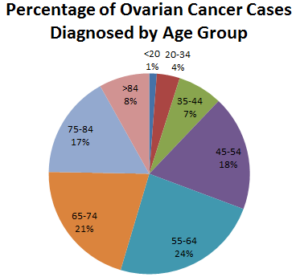
Keilana/CreativeCommons
Dr. Diaz-Montes adds, “Uterine fibroids could present with heavy vaginal bleeding. This is not a common symptom in ovarian cancer.”
Dr. Diaz-Montes is associate director of The Lya Segall Ovarian Cancer Institute at Mercy Medical Center. Board certified in gynecologic oncology, she has conducted various clinical trials to advance the care of gynecologic cancers. Gynecologic Oncology Center
is associate director of The Lya Segall Ovarian Cancer Institute at Mercy Medical Center. Board certified in gynecologic oncology, she has conducted various clinical trials to advance the care of gynecologic cancers. Gynecologic Oncology Center
 Lorra Garrick has been covering medical, fitness and cybersecurity topics for many years, having written thousands of articles for print magazines and websites, including as a ghostwriter. She’s also a former ACE-certified personal trainer.
Lorra Garrick has been covering medical, fitness and cybersecurity topics for many years, having written thousands of articles for print magazines and websites, including as a ghostwriter. She’s also a former ACE-certified personal trainer.
.
Top image: Shutterstock/popovartem.com
Ovarian Cancer Leg Pain vs. IBS: Symptom Comparison

Is there a difference in the way leg pain presents itself if it’s from ovarian cancer as opposed to irritable bowel syndrome?
“Leg pain is not a common symptom of ovarian cancer,” says Teresa P. Diaz-Montes, MD, of the Gynecologic Oncology Center at Mercy Medical Center, Baltimore, MD.
“If leg pain is present, more likely the patient has pelvic pain and pressure. The leg pain tends to be constant and not relieved by movement or rest. The intensity of the pain could vary depending on the size of the pelvic mass.
“Leg pain is caused by compression of the pelvic mass on the pelvic side wall where the nerves that go to the leg are.
“The mass could also cause compression on the blood vessels, causing the leg to be more swollen when compared to the other leg.
“Another cause of leg pain could be the formation of blood clots. Blood clots tend to be more frequent among patients with cancer.
“The pain is located in the calf area. Increased swelling is also associated with formation of blood clots. Blood clots are very dangerous because if dislodged, they can travel to the heart and lungs, causing sudden death.”
IBS Leg Pain
“Leg pain is not a typical complaint in IBS,” begins Nnenna C. Okpara, MD, gastroenterologist and director of endoscopy at the Center for Women’s Gastrointestinal Health, Women & Infants Hospital in Providence, RI.
“When present, however, it is mostly described as a muscular type of pain in the legs, though a few patients also report joint pain.
” No mechanism has yet been identified to explain this symptom, but certain anti-inflammatory medications have been successfully used for such patients.
“Again, this may represent an association of IBS with other comorbid conditions, rather than a specific cause/effect.
“Research has shown some association of IBS with fibromyalgia, a disease which involves multiple areas of pain throughout the body.
“Furthermore, ‘referred’ pain from abnormal intestinal movement could theoretically be sensed as originating from the lower extremities.
“Patients with constipation and IBS do sometimes describe sensation of numbness, or ‘pins and needles’ in one or both legs with hard bowel movements, which may due to impingement of stool-distended colon on the nerve tracts exiting the bottom of the spine into the legs.”
There are so many possible causes of leg pain, which is why discomfort that doesn’t go away should be evaluated.
Dr. Diaz-Montes is associate director of The Lya Segall Ovarian Cancer Institute at Mercy Medical Center. Board certified in gynecologic oncology, she has conducted various clinical trials to advance the care of gynecologic cancer. Gynecologic Oncology Center
is associate director of The Lya Segall Ovarian Cancer Institute at Mercy Medical Center. Board certified in gynecologic oncology, she has conducted various clinical trials to advance the care of gynecologic cancer. Gynecologic Oncology Center
 Dr. Okpara’s clinical interests include colorectal cancer screening, gastrointestinal disease in pregnancy, and management of functional bowel disorders, including IBS and constipation.
Dr. Okpara’s clinical interests include colorectal cancer screening, gastrointestinal disease in pregnancy, and management of functional bowel disorders, including IBS and constipation.
 Lorra Garrick has been covering medical, fitness and cybersecurity topics for many years, having written thousands of articles for print magazines and websites, including as a ghostwriter. She’s also a former ACE-certified personal trainer.
Lorra Garrick has been covering medical, fitness and cybersecurity topics for many years, having written thousands of articles for print magazines and websites, including as a ghostwriter. She’s also a former ACE-certified personal trainer.
.
Top image: Shutterstock/ P Stock
Ovarian Cancer Indigestion vs. IBS: Symptom Comparison

What does the “indigestion” of ovarian cancer feel like and what’s it like with irritable bowel syndrome?
Are there similarities? What are the differences?
“Indigestion (the sensation of abdominal discomfort during or after eating) could be a symptom of ovarian cancer,” says Teresa P. Diaz-Montes, MD, of the Gynecologic Oncology Center at Mercy Medical Center, Baltimore, MD.
“Indigestion that is persistent and that lasts for a prolonged period of time (more than two weeks) and associated with nausea, vomiting, abdominal distention (feeling that clothes are tightly fit), feeling full after eating a small amount of food, changes in weight (mostly unintentional weight loss), shortness of breath, loss of appetite and new-onset constipation could be concerning for a malignancy.”
“If ovarian cancer causes a bowel blockage, then persistent nausea and vomiting, increased abdominal distention and decreased passage of stools, mostly diarrhea, could be observed.
“There will be total absence of normal bowel movements that do not respond to the use of laxatives.”
Indigestion from IBS
“Indigestion is a common complaint among both IBS and non-IBS patients, but usually has vague and unclear meaning,” says Nnenna C. Okpara, MD, gastroenterologist and director of endoscopy at the Center for Women’s Gastrointestinal Health, Women & Infants Hospital in Providence, RI.
“For most, it is reported as a sensation of discomfort or fullness in the upper abdomen, usually following meals. Others describe bloating, gas or visible or sensed abdominal distension.
“Bloating and abdominal discomfort after meals is one of the more common symptoms amongst IBS sufferers.
“Multiple factors can lead to a sensation of abdominal distension, including air in the bowel, stool in the intestines and fluid within the abdominal cavity (known in medical terms as ascites).”
Ascites is pronounced uh-sight-eez (it has Greek origins).
“Ascites is a serious symptom which can occur in the setting of many abdominal and gynecological cancers, particularly ovarian, and should always be promptly investigated.
“In the case of IBS, constipation is a likely cause of bloating and fullness, as well as food intolerances to certain dietary components like lactose, gluten and other poorly digested/absorbed components, the so-called “FODMAPs.”
“Simple remedies including over-the-counter medications for constipation and gas, probiotics and dietary modification may provide improvement or relief.”
Dr. Diaz-Montes is associate director of The Lya Segall Ovarian Cancer Institute at Mercy Medical Center. Board certified in gynecologic oncology, she has conducted various clinical trials to advance the care of gynecologic cancer. Gynecologic Oncology Center
is associate director of The Lya Segall Ovarian Cancer Institute at Mercy Medical Center. Board certified in gynecologic oncology, she has conducted various clinical trials to advance the care of gynecologic cancer. Gynecologic Oncology Center
 Dr. Okpara’s clinical interests include colorectal cancer screening, gastrointestinal disease in pregnancy, and management of functional bowel disorders, including IBS and constipation.
Dr. Okpara’s clinical interests include colorectal cancer screening, gastrointestinal disease in pregnancy, and management of functional bowel disorders, including IBS and constipation.
 Lorra Garrick has been covering medical, fitness and cybersecurity topics for many years, having written thousands of articles for print magazines and websites, including as a ghostwriter. She’s also a former ACE-certified personal trainer.
Lorra Garrick has been covering medical, fitness and cybersecurity topics for many years, having written thousands of articles for print magazines and websites, including as a ghostwriter. She’s also a former ACE-certified personal trainer.
.
Top image: Shutterstock/Emily frost
Ovarian Cancer Pelvic Pain vs. IBS: Symptom Comparison
Two doctors talk about what ovarian cancer pelvic pain and that from irritable bowel syndrome are like.
Pelvic pain can be caused by ovarian cancer. It can also be caused by IBS. Do they feel alike? What are the differences?
Let’s first start with the pelvic pain from ovarian cancer. For this topic is Teresa P. Diaz-Montes, MD, of the Gynecologic Oncology Center at Mercy Medical Center, Baltimore, MD.
Dr. Diaz-Montes first notes that the pelvic pain is usually local to the pelvis: the lower abdominal area, beneath the belly button.
“The pain could be more localized to one side (right or left) of the pelvis depending on the size and location of the ovarian mass,” she says.
“The pain is usually constant and not aggravated by movement. It can be associated with a sensation of pressure in the pelvis.
“A women may complain of a new onset of constipation (difficulty with moving her bowels) or urinary frequency (going to the bathroom to urinate more frequently).
“This is due to the compression of the pelvic mass on the adjacent organs.
“If the mass is too big, it may be able to be palpated on examination. This can also cause abdominal distention and the sensation of bloating.
“The intensity of the pain depends of the size of the mass. When the ovarian mass is small, the pain is dull and described as a discomfort.
“When the mass is larger, the pain could be very intense and sharp, requiring the use of pain medications.”
For pelvic pain associated with irritable bowel syndrome, the physician is Nnenna C. Okpara, MD, gastroenterologist and director of endoscopy at the Center for Women’s Gastrointestinal Health, Women & Infants Hospital in Providence, RI.
“Many IBS patients report chronic pelvic pain,” says Dr. Okpara. “The pain is usually localized to the lower abdominal area, above the pelvic bone, or in the perineal area.
“It is usually referred to as a cramping sensation, which is sometimes worsened by movement of pelvic organs including during intercourse, urination or defecation.
“It is also sometimes exacerbated by menses, supporting a possible role for hormonal factors in the mechanism.
“Such complaints should usually trigger an evaluation of the pelvic organs including ovary, tubes and uterus to exclude structural abnormalities including cancer.
“Pelvic pain, though seen in IBS, has been illustrated in studies mostly as an association, meaning that neither proven to be the ‘cause’ of the other, but merely that a certain group of patients are likely to have both.
“This may point to common underlying factors common to both including depression, somatization and physical abuse.
“Another factor is that many IBS patients have undergone multiple abdominal surgeries over the years, which can lead to development of scar tissue (adhesions) within the abdomen and pelvic cavity, that predisposes to chronic pain.”
Irritable bowel syndrome is a diagnosis of exclusion. Make sure you get cleared of all possible causes of pelvic pain or aching before you get diagnosed with IBS.
That means see a gynecologist first to rule out any problems with the ovaries or other reproductive organs.
Dr. Diaz-Montes is associate director of The Lya Segall Ovarian Cancer Institute at Mercy Medical Center. Board certified in gynecologic oncology, she has conducted various clinical trials to advance the care of gynecologic cancer. Gynecologic Oncology Center
is associate director of The Lya Segall Ovarian Cancer Institute at Mercy Medical Center. Board certified in gynecologic oncology, she has conducted various clinical trials to advance the care of gynecologic cancer. Gynecologic Oncology Center
 Dr. Okpara’s clinical interests include colorectal cancer screening, gastrointestinal disease in pregnancy, and management of functional bowel disorders, including IBS and constipation.
Dr. Okpara’s clinical interests include colorectal cancer screening, gastrointestinal disease in pregnancy, and management of functional bowel disorders, including IBS and constipation.
 Lorra Garrick has been covering medical, fitness and cybersecurity topics for many years, having written thousands of articles for print magazines and websites, including as a ghostwriter. She’s also a former ACE-certified personal trainer.
Lorra Garrick has been covering medical, fitness and cybersecurity topics for many years, having written thousands of articles for print magazines and websites, including as a ghostwriter. She’s also a former ACE-certified personal trainer.
Top image: Shutterstock/Zetar Infinity
Ovarian Cancer Back Pain vs. IBS: Symptom Comparison

Here is a comparison between the back pain of ovarian cancer and that of irritable bowel syndrome.
Though this article should not be used to make a home-based diagnosis, it does have the purpose to help guide women and encourage them to have their ovaries checked if they’re having concerning symptoms.
Even if you suspect only IBS, these symptoms should be evaluated by a physician, since serious diseases other than ovarian cancer can mimic IBS.
“Ovarian cancer related back pain is usually localized to the lower back area,” begins Teresa P. Diaz-Montes, MD, of the Gynecologic Oncology Center at Mercy Medical Center, Baltimore, MD.
“The pain could be more localized to one side (right or left) of the back depending on the size and location of the ovarian mass,” continues Dr. Diaz-Montes.
”The pain is usually constant and not aggravated by movement. Rarely, there is any irradiation of the pain to the legs or any loss of sensation in the legs.”
By “irradiation,” Dr. Diaz-Montes means pain extending from the back and into the legs.
She continues: “It can be associated with a sensation of pressure in the pelvis. A women may complain of a new onset of constipation or urinary frequency.
“This is due to the compression of the pelvic mass on the adjacent organs. The intensity of the pain is very variable.
“If the mass is small, the pain is duller. When the mass increases in size, the pain is more intense, requiring the use of pain medications.”
As you can see, back pain that does not require painkillers does not rule out ovarian cancer. But how does back pain from IBS usually present itself?
Back pain is not a very common complaint among IBS patients, says Nnenna C. Okpara, MD, gastroenterologist and director of endoscopy at the Center for Women’s Gastrointestinal Health, Women & Infants Hospital in Providence, RI.
But she explains, “IBS patients may describe back discomfort as a cramping sensation, similar to menstrual cramps, which may be secondary to generalized pain or fibromyalgia, or linked to referred pain from abnormal bowel motility.
“It is mostly localized to the lower back, and some patients describe it as worse at night. It also appears to worsen with menses.
“NSAIDs, exercise and muscle relaxation therapies do play a role in the management.”
If you’re experiencing suspicious symptoms, have your ovaries checked before you see the gastroenterologist.
Dr. Diaz-Montes is associate director of The Lya Segall Ovarian Cancer Institute at Mercy Medical Center. Board certified in gynecologic oncology, she has conducted various clinical trials to advance the care of gynecologic cancer. Gynecologic Oncology Center
is associate director of The Lya Segall Ovarian Cancer Institute at Mercy Medical Center. Board certified in gynecologic oncology, she has conducted various clinical trials to advance the care of gynecologic cancer. Gynecologic Oncology Center
 Dr. Okpara’s clinical interests include colorectal cancer screening, gastrointestinal disease in pregnancy, and management of functional bowel disorders, including IBS and constipation.
Dr. Okpara’s clinical interests include colorectal cancer screening, gastrointestinal disease in pregnancy, and management of functional bowel disorders, including IBS and constipation.
 Lorra Garrick has been covering medical, fitness and cybersecurity topics for many years, having written thousands of articles for print magazines and websites, including as a ghostwriter. She’s also a former ACE-certified personal trainer. .
Lorra Garrick has been covering medical, fitness and cybersecurity topics for many years, having written thousands of articles for print magazines and websites, including as a ghostwriter. She’s also a former ACE-certified personal trainer. .
Top image: Freepik/azerbaijan_stockers
Empower a Teen Bullying Victim with THIS Exercise
A teen who’s a victim of bullying will gain empowerment with a particular type of exercise — regardless of his or her weight or height.
Are you a teen who continuously gets bullied and sees no end in sight?
Or, are you the parent of a bullied teenager, and you’ve “tried everything” to stop this problem, but it only seems to be getting worse?
Teenagers who keep getting bullied develop a sense of helplessness or powerlessness.
Dealing with this situation should be done in a constructive, rather than destructive, way.
Try THIS to Empower the Victim of Bullying
A type of exercise will go a long way at giving the victim of bullies back some of his or her power. It’s powerlifting.
Powerlifting doesn’t have to be competition. Anyone who performs the three powerlifting moves — whether in their school’s gym, home basement or at the local rec center — is a powerlifter.
“The art and sport of powerlifting is all about putting seemingly unclimbable obstacles in front of you, getting really comfortable with feeling uncomfortable, deciding that your current limitations are unacceptable, and working your rear end off till you summit,” says Jarrett Arthur, one of the highest ranking female Krav Maga (Israeli self-defense) black belt instructors in the U.S., who instructs children and adults in self-defense. And she also powerlifts as part of her training.
I have martial arts training. I’m also a powerlifter. Even though I’m an adult who doesn’t get bullied, vs. a teenager who does…I can still vouch for the effectiveness of powerlifting.

Shutterstock/Vladimir Sukhachev
There’s a reason I don’t get bullied, and it’s not because I’m an adult.
In fact, victims of bullies come in all ages, and the adult version of “schoolyard bullying” is workplace harassment, neighbor-to-neighbor harrassment, abusive marriages and abusive relationships.
Being an adult, in and of itself, does not deter adult perpetrators.
I know I can deadlift a heck of a lot more weight than the average man walking on the street.
This knowledge does something to the vibes that transmit from my body as I’m walking down a street past seedy-looking men.
They receive these vibes. They know I’m not prey.
This doesn’t mean that powerlifting has turned me into a bully. And it won’t turn a victimized teenager into a mean-spirited person, either.

Depositphotos.com
Teen victims of bullying feel powerless enough as it is. They feel helpless and this is downright frightening, because they know that the worst has yet to come: being out on their own as an adult in a dog-eat-dog world.
Powerlifting will empower them. Even if your child is only 13 years old and female…GET HER INTO POWERLIFTING.
It will not stunt her growth. Smoking and poor nutrition will, but not strength training.
Growth is determined by nutrition, what goes into the body, and the parents’ genes!
Ignoring the bullying won’t make it going away, but I’m banking that just a few months of powerlifting most certainly will — or at least, dial it down a few good notches.
 Jarrett Arthur is a leader and innovator in the self-defense space, motivating and inspiring with tools and techniques that work to keep you safer and show up more powerfully in every area of your life.
Jarrett Arthur is a leader and innovator in the self-defense space, motivating and inspiring with tools and techniques that work to keep you safer and show up more powerfully in every area of your life.
 Lorra Garrick has been covering medical, fitness and cybersecurity topics for many years, having written thousands of articles for print magazines and websites, including as a ghostwriter. She’s also a former ACE-certified personal trainer.
Lorra Garrick has been covering medical, fitness and cybersecurity topics for many years, having written thousands of articles for print magazines and websites, including as a ghostwriter. She’s also a former ACE-certified personal trainer.
.
Top image: Shutterstock/fizkes
Do Child Karate Experts Ever Get Bullied?
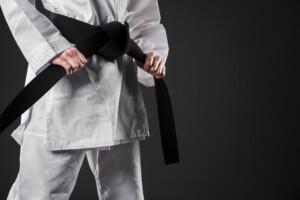
I guess the question isn’t so much do kids with black belts ever get bullied, but rather, do they ever get bullied a second time by the same person?
I’ve trained for years in the martial arts, but I’ve never run a martial arts school, so I decided for this article to consult with someone who does, to get the master instructor’s take on bully-proofing children via martial arts training to the black belt level.
“Everybody has the potential to be bullied, even martial arts black belts, since bullies typically do not respect titles or accomplishments,” says Jarrett Arthur, one of the highest ranking female Krav Maga (Israeli self-defense) black belt instructors in the U.S., who instructs children and adults in self-defense.
Certainly, a bully might decide to pick on the new kid in school who happens to be small in stature or humble in disposition, traits that create the illusion that this individual can easily be preyed upon by bullies.
But this same kid can be prolific in a martial art such as Krav Maga, karate or taekwondo.
The question then becomes: Will the bully likely continue picking on the child who has truly earned a black belt?
And the “picking” here isn’t necessarily physical. Most bullying is non-physical.
Arthur explains that “black belts tend to be kept off of the victim list because they very often possess characteristics that are unappealing to bullies: confidence, self-esteem, verbal and body-language boundary-setting skills, and the know-how to fight back if need be.”
I have witnessed precisely what Arthur has described in the various martial arts schools that I have attended.
I will admit, however, that a few of the schools handed out black belts too prematurely, to kids who exhibited intermediate skills at best.
This is why it’s important that when shopping around for a high quality martial arts school, the parent must be very judicious and discriminant, and not be swayed by slick sales talks or pressure to “sign up now for the great deal” or “get a black belt in 90 days.”
Avoid schools that put the heat on you to sign a long-term contract. And no child or adult can attain a black belt level in only 90 days, no matter what the instructor says. That’s like saying your child can master golf in 90 days.
A child, adolescent or teenager who has truly earned a black belt would be able to make a spectator say, “Dang she’s good!” or “Holy cow!” after seeing a performance of a kata or form.
“Bullies most often look for victims they deem weak, meek and insecure (not adjectives assigned to black belts), so that they have the best chances of successfully putting their targets down in order to pick themselves up,” says Arthur.
 Jarrett Arthur is a leader and innovator in the self-defense space, motivating and inspiring with tools and techniques that work to keep you safer and show up more powerfully in every area of your life.
Jarrett Arthur is a leader and innovator in the self-defense space, motivating and inspiring with tools and techniques that work to keep you safer and show up more powerfully in every area of your life.
 Lorra Garrick has been covering medical, fitness and cybersecurity topics for many years, having written thousands of articles for print magazines and websites, including as a ghostwriter. She’s also a former ACE-certified personal trainer.
Lorra Garrick has been covering medical, fitness and cybersecurity topics for many years, having written thousands of articles for print magazines and websites, including as a ghostwriter. She’s also a former ACE-certified personal trainer.
.
Top image: Freepik.com
Can Karate Prevent Bullied Kids from Suicide Attempts?

Ever wonder why whenever you read of a bullied youth who has died by suicide, the boy or girl was not accomplished in the martial arts?
Though there’s no magic pill that will automatically turn a bullied child away from the idea of attempting suicide, there IS a potent experience that can give a victim enough hope to want to stick around for a while longer.
Bullying, Suicide and Martial Arts
“What we typically see in bullied children who have taken their own life are victims who have reached the lowest level of hopelessness and helplessness,” says Jarrett Arthur, one of the highest ranking female Krav Maga (Israeli self-defense) black belt instructors in the U.S., who teaches children and adults self-defense.
“Oftentimes, those two states of being work hand-in-hand with powerlessness.”
Though dying by suicide is actually very rare in young people, the number of attempts is alarming.
Every year in the U.S., about two million attempts are made—by adolescents.
Nearly 700,000 require medical attention for the attempt. This information comes from the American Academy of Child and Adolescent Psychiatry.
To my knowledge, there’ve been no studies on the effect of martial arts training on the mind of the young bully victim who has been thinking about suicide.
This lack of research doesn’t mean that martial arts would not have a profoundly positive effect.
But why don’t you sit in on a martial arts class for teens and adolescents and see for yourself what it does for self-value, self-esteem and self-discipline?
Sit in on an advanced class, because these kids would have been in the arts long enough for it to have established a powerful effect on their minds.
Sometimes, just belonging to a judgment-free zone is enough to keep the bullied, depressed teen or adolescent from making an attempt at their life.
A high quality martial arts school will often provide a calendar of judgment-free social activities where everyone accepts everyone else, no matter what they look like or where they come from.
I once belonged to a school that had an assortment of activities: bowling nights, movie nights, pizza nights, etc.
Often, bullied kids who think about suicide come from dysfunctional families.
At school they suffer; at home they suffer. There is no escape. But the martial arts school can provide that escape.
Plus, training for tournaments ignites the goal-setting process. Who wants to take a lethal amount of sleeping pills or hang themselves when there’s a growing collection of tournament trophies in their bedroom?
I swear, kids LIVE for trophies! I have seen what being handed a big shiny trophy does to them.
And I’m not talking just about seven-year-olds; I’m also talking about tweens! You’d think they were handed a wad of $100 bills!
Even if the martial arts practitioner doesn’t think he or she will place in that big tournament, the experience alone will keep their spirit hopping!
Martial arts is based upon reaching for one goal after another, and major goals are divided into smaller, bite-sized goals.
This will help detract the young mind of a bully victim from wanting to put an end to it all via suicide.
 Jarrett Arthur is a leader and innovator in the self-defense space, motivating and inspiring with tools and techniques that work to keep you safer and show up more powerfully in every area of your life.
Jarrett Arthur is a leader and innovator in the self-defense space, motivating and inspiring with tools and techniques that work to keep you safer and show up more powerfully in every area of your life.
 Lorra Garrick has been covering medical, fitness and cybersecurity topics for many years, having written thousands of articles for print magazines and websites, including as a ghostwriter. She’s also a former ACE-certified personal trainer.
Lorra Garrick has been covering medical, fitness and cybersecurity topics for many years, having written thousands of articles for print magazines and websites, including as a ghostwriter. She’s also a former ACE-certified personal trainer.
.
Top image: Shutterstock/Kaderov Andrii
Source: nami.org/Content/ContentGroups/Illnesses/Suicide_Teens.htm Karate Prevent Bullied Kids from Suicide
Can Childhood Karate Prevent Adult Abusive Relationships?
Seems that a little girl who takes martial arts lessons will never end up staying in an abusive relationship as a helpless powerless victim.
It’s not always about the ability to knock out a strapping six-foot man.
It’s the ability to feel good enough about yourself, and self-confident enough, NOT to be drawn to violent men in the first place.
Or, to put it another way, feeling secure enough with your place in the world that you’d never STAY with such a man after the first time he exhibits violence.
“Yes, students learn how to physically defend themselves in martial arts classes, but it goes beyond that,” begins Jarrett Arthur, one of the highest ranking female Krav Maga (Israeli self-defense) black belt instructors in America, who teaches children and adults self-defense.

Shutterstock/Fotokvadrat
“The particular life skills taught in martial arts classes can give your child an incomparable boost in their ability to maintain healthy and safe relationships as teens and beyond to adulthood.”
It stands to reason that childhood martial arts training would be a powerful preventive agent in getting involved with an abusive man.
Not that it’s never happened, but let’s take off our blinders and see the logic behind this premise.
“A lack of confidence and self-esteem is one of the biggest factors in young adults and adults engaging in abusive relationships,” explains Arthur.
“Parents have a huge opportunity to build a child’s confidence and subsequently, set them up to be a confident adult.
“Enrolling your child in a martial arts class is one of the best ways to boost their confidence.
“Martial arts curriculums are built to consistently challenge students with difficult but attainable goals, and are quick to highlight achievements through positive praise and celebration both privately (direct praise from a Sensei) and publicly (being awarded with a new belt or stripe in front of the entire class).”
Women Who Stay in Abusive Relationships Lack Self-Advocacy
“Self-advocacy, or an individual’s ability to effectively communicate, convey, negotiate or assert his or her own interests, desires or needs, is a skill often overlooked, partly because it’s mistakenly confused with back-talk or disrespect,” Arthur explains.
“Back-talk is very different from self-advocacy and can be differentiated by tone of voice, body language and subject.
“Your child whining about not wanting to do homework is very different from a child using clear, concise words to tell a bully that what he/she is doing is not okay.
“Martial arts programs tackle this life skill head-on by encouraging respect, while teaching kids how to effectively communicate using their words and body language (like eye contact).
Reputable schools will have students participate in role-playing scenarios so that students can get hands-on practice standing up for what they want and need in appropriate situations (like bullying) in a confident and effective, but respectful way.”
Parents should do their homework when hunting for a high quality martial arts school and not be pressured into signing long-term contracts with so-called black belt factories or “McDojos.”
Arthur continues, “It’s often hard to recognize an abusive relationship, especially one in which no physical abuse takes place.
“While most martial arts schools will leave explicit discussions of abuse off the table, many will lead lessons plans geared towards recognizing situations and relationships that don’t feel good, or ones that are not mutually positive and beneficial.
“I teach kids as young as five the difference between a joke and bullying because it helps them begin to learn what behavior by their peers and partners is ok, and what is not.”









